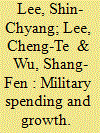| Srl | Item |
| 1 |
ID:
143602


|
|
|
|
|
| Summary/Abstract |
The paper analyzes the effects of military spending on economic growth in a small open stochastic endogenous growth model involving the supply-side and demand-side effects produced by military spending. We show that a rise in the military spending affects economic growth through four channels, including the crowding-out effect, the spin-off effect, the resource mobilization effect, and the portfolio effect. The net effect which depends on these four channels is ambiguous. Hence, we demonstrate that there exists an optimal defense burden that maximizes the economic growth rate.
|
|
|
|
|
|
|
|
|
|
|
|
|
|
|
|
| 2 |
ID:
103947


|
|
|
|
|
| Publication |
2011.
|
| Summary/Abstract |
This article tests the validity of a Forward Discount Bias Puzzle, in a small open developing economy (SODE)-Sri Lanka-by employing first an unstructured vector autoregression (VAR) model and then a structured VAR model. The author argues that empirical examinations concerning SODEs cannot merely replicate methodology followed in testing developed economies, and identifies the need to disentangle capital flows from interest rate changes by including both capital flow and monetary policy variables. The article finds no evidence of a Forward Discount Bias Puzzle in Sri Lanka, and that perfect capital mobility is a too strong assumption. Hence, it proves that empirically more appropriate approach is to assume some capital mobility and incorporate capital flow data to accommodate for this change, in the analysis of UIRP.
|
|
|
|
|
|
|
|
|
|
|
|
|
|
|
|